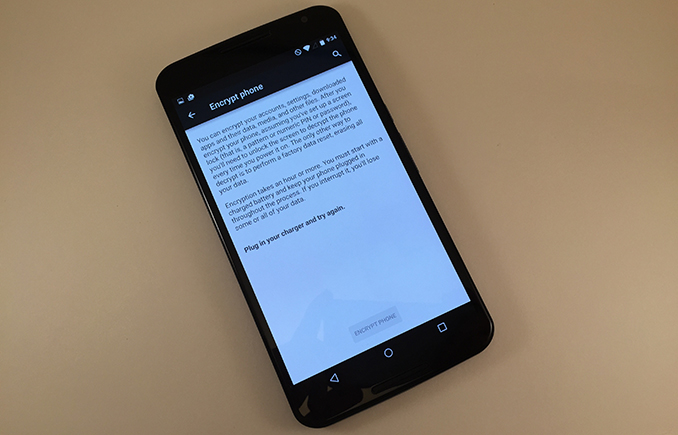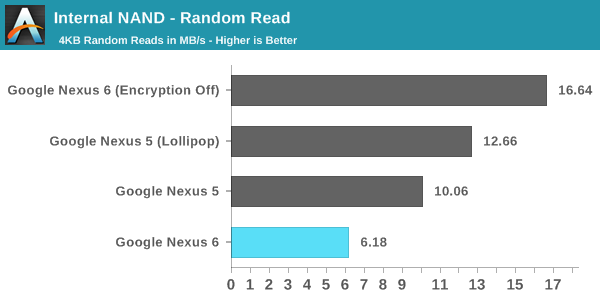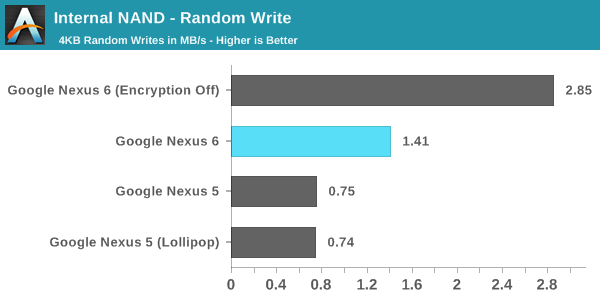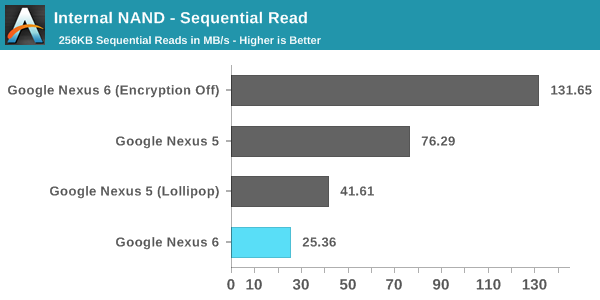Encryption and Storage Performance in Android 5.0 Lollipop
by Brandon Chester & Joshua Ho on November 20, 2014 8:00 AM EST
As alluded to in our Nexus 6 review, our normal storage performance benchmark was no longer giving valid results as of Android 5.0. While Androbench was not a perfect benchmark by any stretch of the imagination, it was a reasonably accurate test of basic storage performance. However, with the Nexus 5 on Android’s developer preview, we saw anywhere between 2-10x improvement to Androbench’s storage performance results with no real basis in reality. It seems that this is because the way that the benchmark was written relied upon another function for timing, which has changed with Android 5.0.
While we haven’t talked too much about AndEBench, it has a fully functional storage test that we can compare to our Androbench results. While we’re unsure of the 256K sequential and random read results, it seems that the results are equivalent to Androbench on Android 4.4 when a 1.7x scaling factor is applied. However, AndEBench results should be trustworthy as we saw no difference in results when updating devices from 4.4 to 5.0. In addition, the benchmark itself uses low level operations that shouldn’t be affected by updates to Android.
| Androbench Results - Valid vs. Faulty | ||
| Nexus 5 Androbench Results on 4.4 KitKat | Nexus 5 Androbench Results on 5.0 Lollipop | |
| Random Read | 10.06 MB/s | 27.70 MB/s |
| Random Write | 0.75 MB/s | 13.09 MB/s |
| Sequential Read | 76.29 MB/s | 182.78 MB/s |
| Sequential Write | 15.00 MB/s | 47.10 MB/s |
As you can see, the results show a degree of improvement that is well beyond what could realistically be accomplished with any sort of software optimizations. The results for the random write test are the most notable, with a result that suggests the performance is over 17x faster on Android Lollipop, which could not be the case. This required further investigation, and it's one of the reasons why we were hesitant to post any storage benchmarks in the Nexus 6 review.
The other factor affecting the results of the benchmarks on the Nexus 6 specifically is Android Lollipop's Full Disk Encryption (FDE). Android has actually had this ability since Android 3.0 Honeycomb, but Lollipop is the first time it's being enabled by default on new devices. When FDE is enabled, all writes to disk have the information encrypted before it's committed, and all reads have the information decrypted before they're returned to the process. The key to decrypt is protected by the lockscreen password, which means that the data should be safe from anyone who takes possession of your device. However, unlike SSDs, which often have native encryption, eMMC has no such standard. In addition, most SoCs don't have the type of fixed-function blocks necessary to enable FDE with little to no performance penalty.
As a result, we've observed significant performance penalties caused by the use of FDE on the Nexus 6. Motorola was kind enough to reach out and provide a build with FDE disabled so we could compare performance, and we've put the results in the graphs below. For reference, the Nexus 5 (Lollipop) numbers are run using Andebench, while the original values are read out from Androbench on Android 4.4. The Nexus 5 is also running without FDE enabled, as it will not enable itself by default when updating to Lollipop via an OTA update.



As you can see, there's a very significant performance penalty that comes with enabling FDE, with a 62.9% drop in random read performance, a 50.5% drop in random write performance, and a staggering 80.7% drop in sequential read performance. This has serious negative implications for device performance in any situation where applications are reading or writing to disk. Google's move to enable FDE by default also may not be very helpful with real world security without a change in user behaviour, as much of the security comes from the use of a passcode. This poses a problem, because the users that don't use a passcode doesn't really benefit from FDE, but they're still subject to the penalties.
When the Nexus 6 review was published, I commented that there were performance issues that weren't present on the Nexus 5 running Android Lollipop. Many users commented that the FDE may have been to blame. Like I mentioned earlier, Motorola provided us with a build of Android with FDE disabled. Unfortunately, I haven't noticed any improvements to many of the areas where there are significant frame rate issues such as Messenger and Calendar. I speculated in the Nexus 6 review that the performance issues may simply be the result of insufficient GPU performance or memory bandwidth to drive the QHD display.
To me, the move to enable FDE by default in Lollipop seems like a reactionary move to combat the perception that Android is insecure or more prone to attack than iOS, even if that perception may not actually be accurate. While it's always good to improve the security of your platform, the current solution results in an unacceptable hit to performance. I hope Google will either reconsider their decision to enable FDE by default, or implement it in a way that doesn't have as significant of an impact on performance.










91 Comments
View All Comments
benjdm - Friday, November 21, 2014 - link
Thanks Brandonmacs - Thursday, November 20, 2014 - link
I just sent back my Nexus 9.Coming from an iPad air those lags are not acceptable. I can't stand a wallpaper that reloads when I tap the home button. Lollipop is far from a finished product.
sweenish - Thursday, November 20, 2014 - link
Easy enough to fix with a third-party launcher that offers the ability to stay in memory.But I have to wonder why you even bothered with Android if you want everything handed to you on a platter?
I get that as far as initial polish and presentation go, Android still lags though it's been making great strides. But to forego one of Android's chief advantages (changing things to get what you want) and just return a device?
It's like buying a sports car and taking it back because you can't do all your driving in second gear. Or buying a leatherman only for the screwdriver.
steven75 - Thursday, November 20, 2014 - link
Why do you give google get a free pass for releasing unfinished products? Very bizarre!A more valid car analogy would be buying a car with door locks that only activate half the time. Your solution is to replace the locks while 99.9% of the world would take the POS back for a refund.
Deelron - Thursday, November 20, 2014 - link
There's a difference between changing the things you want and fixing problems. Yay for customizing, boo for fixing.macs - Thursday, November 20, 2014 - link
I'm a tech enthusiast and I like both iOS and Android. There are pros and cons on both. This is not the point. But the Nexus 9 to me RIGHT NOW is a beta product. I didn't personally tried other devices with lollipop but what I heard is that the problems are the same (lags, unprectidable performances,...)tralalalalalala40 - Friday, November 21, 2014 - link
I feel for all the android fanbois that buy an N9 because it's an android tablet. They are getting screwed for their money considering the value of an iPad air 2.andrewaggb - Monday, November 24, 2014 - link
Companies screw up, but it's definitely not a free pass. You have a small window of time to make things right.Sounds like this is a mistake. Going up against the ipad air 2 you needed your complete A game.
tuxRoller - Thursday, November 20, 2014 - link
Yup pretty awful.My 2013 n7 is jankier now than with 4.4.
ART, as currently implemented, has been a bust. They really oversold android l.
psyside1 - Thursday, November 20, 2014 - link
So how come GPU with 50% more horsepower, and 30GB/s based S805, its still not enough? i think we are seeing lack of software optimizations, not QHD/big resolutions lags.